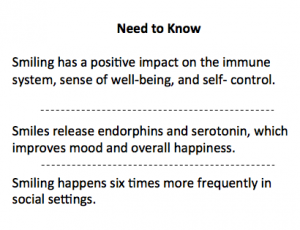A Smile is Not Just a Smile. Nonverbal: Part Four
Sept. 28, 2015 ~ Written by: W.B. “Bud” Kirchner
 This is the final installment of our series on nonverbal communication. So far, here is what I have covered:
This is the final installment of our series on nonverbal communication. So far, here is what I have covered:
- “Part One: It’s Not What You Say, It’s How You Show It” (what to look for)
- “Part Two: When a Burp is a Thumbs Up: Culturing Your Nonverbal Communications” (understanding nonverbal impact)
“Part Three: A Field Guide to Nonverbal Communications” (tips for receiving and giving nonverbal signals)
Because Exploring the Business Brain is based on our Business Brain Model℠, there is a constant theme – holistic approaches. Today I ask you to think of the smile as a holistic signal when it comes to nonverbal communication.
“I’d rather have a fake smile than a nasty stare,” ~ Tamara Ecclestone, model
Smile Therapy
I am also intrigued by the fact that at least one version of the smile cannot be faked. Think about that! When did you last hear about a spoken word that couldn’t be twisted?
Another reason for a focus on the smile is its inherent ability to make us feel healthier, happier and more confident. To different degrees this is a benefit to both sender and receiver. If you think back to our performance post you will understand the implications here.
Physiologically – smiles have been shown (real science) to have a positive impact on immune system, sense of well-being and self-esteem, blood pressure, self-control and resilience against stress.
Biochemically – smiles release endorphins and serotonin. Endorphins (natural painkillers) enhance our immunity. Serotonin (natural anti-depressant) enhances our mood. Certain people on Wall Street would (do) pay a lot for a pharmaceutical that could do this!!
While this is Part Four of a series on nonverbal communication I thought it was clever to introduce performance, neurotransmitters, body/mind linkage, etc. all of which are in future posts. I couldn’t resist the temptation!
A Simple Smile
Smiles, given there (muscular) nature, integrate the entire face – eyes, lips, etc. I know I segregated the eyes from the face in “Part Three: A Field Guide to Nonverbal Communications,” but now we are considering them together for reasons that will become obvious.
When you smile it all starts in your brain (surprise!), which transmits the signal thru the seventh cranial nerve. The pathways for smiling are quite complicated, with both unconscious and conscious connections that receive inputs from different parts of the brain but are hardwired to display emotion. This will stimulate the zygomatic major muscle, which pulls up the corners of the mouth. Pretty simple – pretty mechanical (actually neuromuscular)!
However, then magic sets in if it is a ‘true’ smile. The orbicularis oculi muscle engages at the tip of the cheek and around the eyes and is involved in pulling down the eyebrows and the skin below the eyebrows, then pulling up the skin below the eye and raising the cheeks.
I have, of course, simplified this a bit – there are 43 muscles in the face and some people argue about how many of them get engaged in the spectrum of smiles and related expressions but we are going with the KISS (Keep It Simple, Stupid) principle. Having said that, comedians like Jim Carrey are likely in part successful because they can make facial expressions most people can only make involuntarily.
The Duchenne Smile
We’ll come back to other aspects later, but for the discovery by 19th century neurologist Guillaume-Benjamin-Amand Duchenne – the product of the above is known as: The Duchenne Smile. (Incidentally, Paul Ekman, who we mentioned in an earlier post, substantiated much of his work.)
Imagine having a smile named after you!
(One quick caveat and one that makes me cringe about the world we live in – the only exception to the above is if someone has had Botox treatments!)
The pre-Botox Duchenne concluded the mouth smile conveys the will but the eye (‘true’) smile does not – in other words it is a perfect mirror of our emotion since you cannot voluntarily contract these muscles.
Let’s make this straightforward: crow’s feet around the eyes mean you are doing business with someone who wants to do this business and with you!!
The Power of a Smile
How powerful is a smile phenomenon? “The Face of Emotion,” by Eric Finzi, as well as other sources I have read, point out some amazing items.
- The smile is one of the first emotions to manifest itself in infants.
- The smile transcends almost all cultures.
- Those who are born blind will still smile despite the fact they have never seen a smile.
- A smile happens six times more frequently in a social setting.
- People who have suffered brain damage may not be able to smile when asked to, but will still involuntarily smile at a joke.
- Believe it or not (you gotta love science) they have developed a connection between smiles on baseball cards and the longevity of the player.
“A gentle word, a kind look, a good-natured smile can work wonders and accomplish miracles.” ~ William Hazlitt
The Duchenne smile also appears to be a strong indicator of success. If one were so inclined, you could speculate on the cause vs. effect. Researchers at the University of California, Berkeley studied the expressions of women in the college yearbook. Just under half displayed the Duchenne smile —and the subject’s “positive emotional expression predicted favorable outcomes in marriage and personal well-being up to 30 years later.”
If you feel compelled to have a more scientific treatment of this topic – I direct you to the Association for Psychological Science article “The Psychological Study of Smiling,” by Eric Jaffe.
About the Author: W.B. “Bud” Kirchner is a serial entrepreneur and philanthropist with more than 50 years of business success. He is not a scientist or an academic but he does have a diversified exposure to neuroscience, psychology and related cognitive sciences. Generally speaking, the ideas he expresses here are business-angled expansions of other people’s ideas, so when possible, he will link to the original reference.
